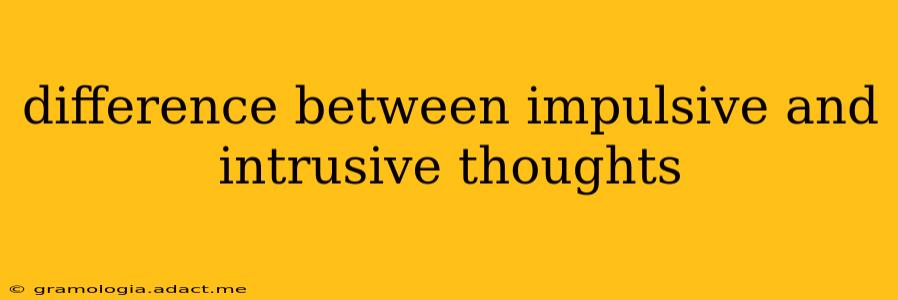Understanding the difference between impulsive and intrusive thoughts is crucial for managing mental health. While both can be distressing, they stem from different cognitive processes and require different approaches to manage. This article will explore the key distinctions, helping you better understand these thought patterns and, if necessary, seek appropriate support.
What are Intrusive Thoughts?
Intrusive thoughts, also known as unwanted thoughts, are sudden, unwelcome, and often disturbing thoughts, images, or urges that pop into your mind unexpectedly. They are typically unwanted and distressing, causing significant anxiety or distress. These thoughts often contradict your values and beliefs. Common examples include fears of harming yourself or others, contamination fears, or obsessive thoughts about order and symmetry. Crucially, individuals experiencing intrusive thoughts do not want to act on them. The presence of the thought itself is the source of the distress.
Are Intrusive Thoughts a Sign of Mental Illness?
While intrusive thoughts can be distressing and are a common symptom of certain mental health conditions like Obsessive-Compulsive Disorder (OCD), experiencing them doesn't automatically mean you have a mental illness. Many people experience intrusive thoughts occasionally without any underlying condition. The key difference lies in the frequency, intensity, and the level of distress caused by these thoughts. If intrusive thoughts are significantly impacting your daily life, causing considerable anxiety or interfering with your ability to function, seeking professional help is recommended.
What are Impulsive Thoughts?
Impulsive thoughts are sudden urges or desires to act on a specific behavior without forethought or consideration of the consequences. Unlike intrusive thoughts, which are often distressing because they are unwanted, impulsive thoughts may feel compelling, even if you recognize they’re potentially harmful or unwise. These thoughts lead to immediate action or a strong desire for immediate action. Examples could include: suddenly yelling at someone, spending money uncontrollably, or engaging in risky behavior. The key difference is the urge to act versus the distress caused by the thought itself.
Impulsive Thoughts and Impulse Control Disorders
Impulsive thoughts are often associated with impulse control disorders. These disorders involve a significant impairment in the ability to resist impulses, urges, or temptations. Examples include kleptomania (the urge to steal), pyromania (the urge to set fires), and intermittent explosive disorder (characterized by episodes of aggressive behavior). However, experiencing impulsive thoughts occasionally doesn't necessarily indicate a disorder. Many people experience occasional impulsive urges without it being clinically significant.
Key Differences Summarized
| Feature | Intrusive Thoughts | Impulsive Thoughts |
|---|---|---|
| Nature | Unwanted, unwelcome, disturbing thoughts, images, or urges | Sudden urges or desires to act on a specific behavior |
| Motivation | None; the thought itself is distressing | Strong urge to act, often without considering consequences |
| Action | Rarely acted upon; the person resists the impulse | Often acted upon; may lead to immediate behavior |
| Emotional Response | Anxiety, distress, fear | Excitement, relief (after acting), guilt (after acting) |
| Association | OCD, anxiety disorders | Impulse control disorders, ADHD |
How to Manage Intrusive and Impulsive Thoughts
Both intrusive and impulsive thoughts can be effectively managed with various techniques. These include:
- Cognitive Behavioral Therapy (CBT): CBT helps identify and challenge negative thought patterns and develop coping mechanisms.
- Exposure and Response Prevention (ERP): A specific type of CBT used for OCD, helping individuals gradually confront their fears and resist compulsive behaviors.
- Mindfulness and Meditation: These practices can help increase awareness of thoughts and urges without judgment, reducing reactivity.
- Impulse Control Techniques: Strategies to manage impulsive urges, such as deep breathing exercises, taking breaks, and seeking distraction.
This information is for educational purposes only and is not a substitute for professional medical advice. If you are struggling with intrusive or impulsive thoughts, please seek help from a qualified mental health professional. They can provide a proper diagnosis and develop a personalized treatment plan.
